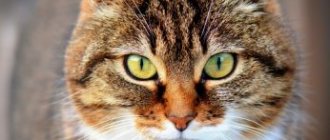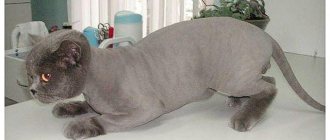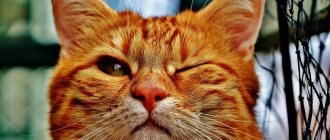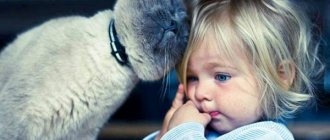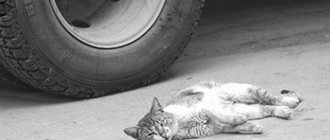Types of haircuts
Typically, cat care does not include a mandatory haircut. However, in some cases this procedure can be useful and even necessary. The following types are distinguished:
- Hygienic significantly simplifies the life of owners of long-haired breeds, relieving them of the need to comb their pet daily to avoid tangles. It is also carried out in cases where indelible substances are stuck to the fur (for example, paint, chewing gum), during the molting period, if the animal is susceptible to frequent formation of hair balls in the digestive system, as well as during the summer heat, when the cat’s fur is too warm and can lead to to overheating. In addition, it is recommended to trim old and sick cats if they are unable to care for themselves.
- Treatment is carried out on the recommendation of a veterinarian for infestation with lice and fleas, allergic dermatitis and hyperplasia of the sebaceous glands. Removing excess hair makes it easier to apply medications to the animal's skin. In some cases, complete shaving of the hair is indicated.
- Decorative or modeling is carried out at the request of the owner. The most common haircuts are “lion”, “dragon”, “puma” and “puss in boots”.
- Exhibition is done with the aim of giving the animal the appearance accepted for a given breed at exhibitions. Most often, this is done by qualified hairdressers in pet salons, but some owners learn to cut their pets' hair on their own. It is recommended to conduct it no later than six months before the exhibition.
Why cut your cat's hair?
There are several reasons why you should cut your cat's hair. Conventionally, they can be divided into two types - for health and for beauty. If we talk about the appearance of the animal, it is a matter of taste of its owner. It is important to highlight the reasons related to the pet's health.
When does a cat need a hygienic grooming:
- tangles form on the wool;
- there are problems with the gastrointestinal tract associated with swallowing wool - vomiting, constipation, diarrhea;
- there are problems with shedding;
- the owner is allergic to animal fur;
- It is easier to treat against ticks or fleas.
It is worth noting that grooming will not completely solve the problem of a person’s allergy to wool, but it will reduce the amount of fluff, which means there will be less of the causative agent of the allergic reaction. The haircut is perfect for owners who do not have time to brush their pet every day.
Using a machine will eliminate the need for regular brushing and the need for frequent cleaning of the apartment, especially carpets that catch cat hairs. It is worth remembering that grooming is recommended no more than once every four months. Often owners of purebred cats choose fashionable haircuts. There is an opinion that a short-haired cat can withstand the heat more easily, but this is rather a myth. Wool performs the function of thermoregulation, which prevents the animal from overheating.
Trimmed cats in the French Lion style.
Cases when a haircut is undesirable
With all the advantages of a haircut, you should consider situations when it is better not to do it:
- The cat belongs to the short-haired breed.
- The animal lives or happens to be in cool places.
- There is often air conditioning in the room.
- The cat's fur does not need to be shortened.
- The kitten is still too small (under three months).
Also, experts do not recommend cutting the fur too short without good reason - its minimum length should be at least 3 mm.
Haircut frequency
The optimal frequency of trimming depends on the breed of cat: they differ in the length, thickness and speed of hair growth.
Most often (up to four times a year) long-haired breeds need grooming: Persians, Ragdolls, Siberian and Angora cats, Maine Coons. Cats with medium-length hair, for example, British and Scottish Fold, need to be cut once or twice, preferably before the warm season.
Unscheduled haircuts are required if mats have formed on the fur. They cause severe discomfort to the animal, tightening the skin and preventing air exchange, which can create a favorable environment for the development of skin diseases.
Alternatively, you can trim the tangles as they appear, but this method has two significant disadvantages: firstly, there is a risk of accidentally injuring the cat’s skin, and secondly, it can cause damage to the cat’s appearance.
Grooming for short-haired cats with close-coated hair (Orientals, Abyssinians)
In our Articles section you will also find a separate guide to caring for Abyssinians. Today we will briefly discuss the most important points in caring for the fur of cats of these breeds.
You will need a rubber slicker brush with fine teeth, a special rubberized mitten and a small piece of suede. Cats of these breeds do not require daily care. It will be enough if you find the opportunity to brush your pet 1-2 times a week.
First you need to comb the fur with a comb against the grain, and then repeat the procedure for hair growth. Use a mitt to remove any remaining hairs. Then apply protein conditioner to your pet’s fur. After drying, you can complete the procedure by polishing the wool with a piece of suede.
Let us remind you that you can purchase everything you need to care for your pet’s coat in our online store. We talk about what grooming features exist for short-haired cats of plush breeds, as well as semi-long-haired and long-haired cats in our next article.
Mr. Cat recommends: varieties of model haircuts
Model haircuts are carried out with the aim of ennobling the animal’s exterior, emphasizing its individual characteristics or highlighting it through unusual, sometimes funny elements. When choosing a hairstyle, owners and groomers are guided by fashion trends and their own imagination. Such haircuts look especially impressive if the cat's undercoat is a different color than the top layer of fur.
The following varieties are distinguished:
- “Lion” is the most common type, when the entire body is shaved, except for the head, tail and paws.
- “Puma” or “Tulupchik” resembles “Lion”. The difference is that the front part of the body to the middle of the chest remains uncut - as if the cat is wearing a sheepskin coat made of its own fur.
- “Dragon” - hair on the head and paws, a strip along the spine is cut into teeth, and the tail is a herringbone or spiral.
- “Puss in Boots” is a version of “Lion” with intact fur on its paws.
In addition to ready-made haircut models, there are several basic elements that can be combined with each other to create new looks:
- "Tassel" on the tail.
- “Broom” - like “Brush”, only the hair at the end is cut straight.
- “Squirrel” - fluffy fur on the entire tail, except the very beginning, remains untouched.
- “Herringbone” - the fur on the tail is cut in several funny “brooms” one after another.
- “Knee socks” - paws are cut to the elbow.
- “Socks” are shorter than “socks”, below the elbow.
- Patterns - due to the difference in length, three-dimensional figures, letters and ornaments are cut on the wool.
Prices for haircuts in the salon and at home
In the salon, haircuts are performed by an experienced groomer, whose work experience allows the procedure to be carried out faster and with better quality. In addition, he always has the necessary instruments and equipment at hand, and aggressive animals can be given anesthesia with veterinary permission.
The cost of such grooming starts from 500 rubles and increases depending on the type of haircut and the level of the salon. The average price of a full hygienic haircut is 2,000 rubles.
But despite all the advantages, the trip carries a lot of stress on the cat: transportation in transport, an unfamiliar place with a lot of new faces, smells and sounds can greatly frighten him. If your pet does not tolerate such situations well, it is better to call a groomer at home. Departure will cost an additional 200-300 rubles, but in a familiar home environment the cat will be much calmer. Many salons offer, for an additional fee, an assistant groomer who will secure the animal during the procedure.
How to reduce unpleasant consequences to a minimum?
To alleviate the stressful state, you need to try to gradually reconcile the animal with the procedures performed. The main method is psychological:
- rid the cat of contact with unpleasant objects - nail clippers, scissors, hair clippers;
- distract with treats, new toys, favorite activities;
- during and after the manipulations, constantly talk and stroke;
- Do not laugh or focus on the appearance of the trimmed cat.
Home haircut
Brave owners who decide to do grooming on their own, without the help of a professional, should take care to carefully organize the process.
Haircutting tools and accessories
First of all, you need to make sure that you have everything you need at hand during the procedure. Namely, you will need:
- Grooming table - instead, you can use a regular ironing board covered with a clean cloth.
- Latex gloves
- A special trimmer for cutting cats - the longer the coat and the thicker the undercoat, the more power the clipper will require.
- Scissors with rounded ends for cutting.
- Thinning scissors for final processing.
- Brush for combing wool before and after cutting.
- Cotton wool and disinfectant (such as hydrogen peroxide) in case of cuts.
Preparation
Before grooming, it is recommended to remove the collar, trim the cat’s claws, and give timid animals a sedative (for example, Stop-Stress, Fospasim, etc.). You should also take care of an assistant who will immobilize and calm the cat during the procedure.
The cat needs to be placed on its side, holding the front legs with one hand and the hind legs with the other. Do not hold it too tightly so as not to cause pain or discomfort to your pet.
Haircut process
You should start with the area along the spine, then proceed to the sides and stomach. The tail and paws are trimmed last. You should not remove hair below the elbows - the cat’s paws should remain in their “socks”.
The haircut can be carried out both in the direction of hair growth and against it. In this case, the skin must be slightly stretched to avoid the formation of folds - this can easily injure the animal. Be careful when treating uneven areas with sensitive skin: armpits, groin, nipples.
If you use a trimmer when cutting, you should choose knife No. 3, and after finishing, mill the wool with scissors.
If there are tangles in the wool, you need to use a special device to remove them - a tangle cutter. It can be replaced with a comb, fixing it between the skin and the tangle so as not to injure the animal with scissors.
It is forbidden:
- trim the hair on the head, ears and tip of the tail;
- trim whiskers and vibrissae;
- use tools not intended for grooming: ordinary scissors with sharp ends, trimmers for cutting people's hair.
After the haircut
After completing the procedure, you must carefully comb the trimmed hair out of the fur, and then wash the cat with shampoo. If it is clear that the animal is very stressed, it is not recommended to wash it immediately - just wipe it with a wet towel. To make the fur dry faster, you can dry it with warm air from a hairdryer - provided that the cat is not afraid of noise.
Recommendations for different cats
There are several subtleties based on the characteristics of the breeds.
When machine grooming cats with long, soft hair, you should go through each area several times, slowly, so that the clipper does not slip or get stuck.
Persian cats often react very aggressively to the procedure. To cope with the animal, you will need a skilled assistant.
If grooming is too stressful for your pet, it is better to avoid it.
British cats are short-haired and do not require hygienic grooming. Regular brushing provides them with proper care.
Angoras are cats with a very weak undercoat and require more frequent grooming than other breeds. Their coat is similar in structure to human hair, and its condition improves with regular grooming.
Maine Coons have a coat that grows very slowly. Among their owners, there are those who argue that these cats should not be cut at all, because the guard hairs may not recover after the procedure. Owners who decide to groom should be prepared for the fact that it will take a long time to grow the fur.
What is cat grooming?
Grooming a cat is a set of procedures to maintain its well-groomed appearance, which includes bathing, combing, hair trimming, as well as caring for claws and ears.
When talking about cat grooming, most often they only mean cutting the cat's hair. But this is not entirely true. Haircut is one of the stages of grooming and is most often performed in a specialized salon by a professional groomer. The hygienic grooming procedure can be performed by any cat owner at home.
Reasons for stopping hair growth
Sometimes owners experience a cessation or slowdown in fur growth after the procedure. This usually occurs due to alopecia - pathological hair loss, most often characteristic of cats of long-haired breeds. It manifests itself as redness and itching in certain areas of the skin.
Sometimes animals make the situation worse by scratching the damaged areas until they bleed.
Haircuts often provoke the development of this disease, but its causes lie in other factors:
- Unbalanced diet: lack of vitamins and minerals.
- Hormonal imbalance in the body.
- Side effects from taking medications.
- Allergy.
If you suspect alopecia, you should immediately contact your veterinarian.


